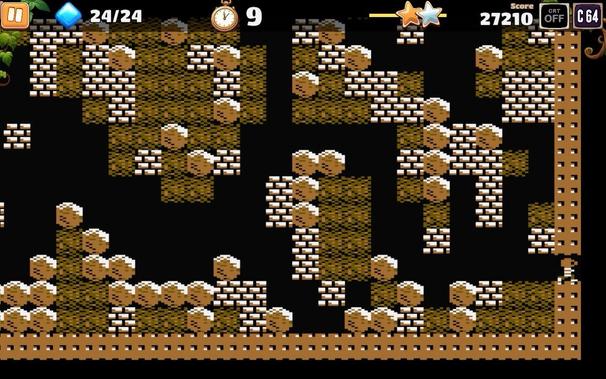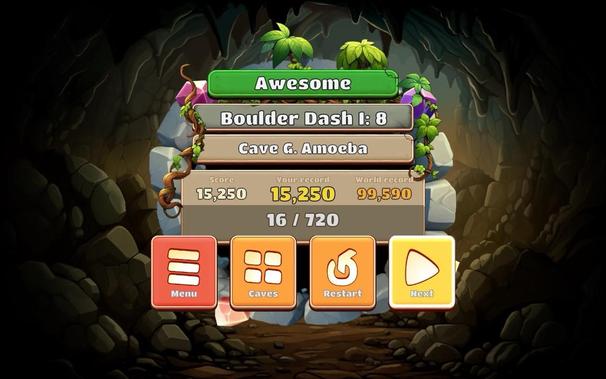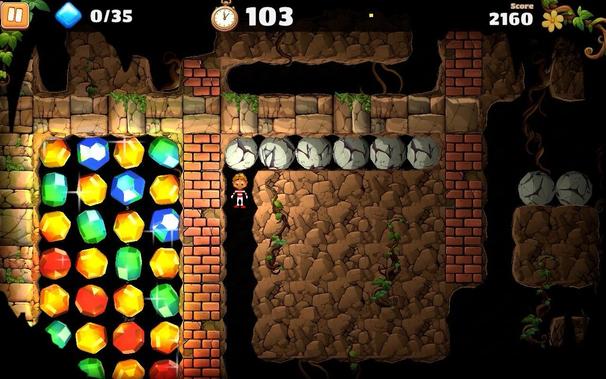Boulder Dash 40th Anniversary – SteamDeck Review
Wow. What a blast from the past. I have a conflicting mixture of memories from my time playing Boulder Dash on what I think was the Commodore 64 – the graphics check out at least. It was both an enigmatic and enthralling game, and an absolute nightmare.
Time has changed neither of these things. Though thanks to its 40th Anniversary release – and its tutorials – I now have a much better understanding of the levels that I struggled with as a child. Y’know, so I can struggle with them again as an adult.
The premise of Boulder Dash is simple. Simple enough that I remade it for the ill-fated 32blit handheld. You must dig through earth, collect diamonds, and avoid falling rocks. Rocks will fall under certain conditions- if you clear the dirt around them, or walk beneath them- and squash you. Diamonds will too, just to be especially cruel. This simple gameplay loop exercises and fuses skill and dexterity of movement – vital for avoiding falling rocks – with the planning and foresight required to not get yourself into a sticky situation. Some levels play like puzzles, and some play like tests of your controllers input latency. Most play like a mix of both. And to make sure you don’t get complacent, they all have a time limit.
Love the oldschool graphics, these are what I remember and what I sought to recreate with Rocks n Diamonds.
Rocks are not your only concern, though, since you will encounter enemies with predictable movement patterns that I never seem able to predict and amoebas with unpredictable movement patterns that I never seem to be able to contain. There’s more, too, but I don’t want to spoil the fun.
What emerges is a game that feels simple, but manages to be challenging on multiple fronts.. It also does this across a completely absurd 720 level of which I have completed under 60 at time of writing. Look I love Boulder Dash, but I have other things to do! These levels explore the movement and puzzle mechanics in excruciating detail, with everything from tight, single-screen mazes encouraging practised fast and precise movement to sprawling caverns with devious traps.
There are, of course, levels you must replay in order to have some idea how to complete them- a sort of route-finding memory game. I’m not entirely sure how I feel about puzzles requiring clairvoyance rather than offering context clues to the solution but they’re there if you want them. In some cases a level might feel like this, but thinking on your feet can get you through.
I’m sure high scores, world records and star ratings won’t lead to an unhealthy obsession with this game 🤣
Motivating you to traverse these levels is a Bronze/Silver/Gold star rating system, which I believe is determined by your completion time and number of diamonds collected. There’s also an overall score, measured against your own high score and the “World Record” which might encourage you to replay levels.
Graphically you’ve got Boulder Dash 1 & 2 with C64 and Atari versions. They look like I remember the – presumably – C64 Boulder dash and I must attest to liking the visual simplicity of these classic versions. A vast majority of the levels are in the revised style, however; a busy, modern 2.5D view with glowing crystals. It has some admittedly nice, if a little superfluous, variation in the look of boulders, bricks and dirt but I can’t help but want to switch the modern levels to a more classic view. That said, I’d totally believe this is how Boulder Dash would have looked had the technology been available at the time and some of the darker, moodier and more challenging levels definitely suit the style well.
Modern graphics aren’t quite so compelling, but they do feel very DOS-era PC. I could imagine this is how Boulder Dash might have looked if it could have.
There’s also Boulder Dash 3 with departs from 1 & 2 with a bafflingly confusing presentation which I can’t force my brain to understand- in lieu of dirt and rocks it appears to have metal balls and riveted bulkheads and this predictably wreaks havoc on my ability to read the game and react accordingly. Can’t win ‘em all, I guess?
Overall it’s a great game. It brings back a small obsession from my childhood of precious few Commodore 64 games and slathers an almost insurmountable number of new levels on top, very much stretching the format – and your skills – to their absolute limits.
What’s more, it’s absolute fodder for the Steam Deck. Everything feels sized with the handheld in mind, and buttons are big enough to handle touch input even if – outside of tapping the C64/Atari and CRT filter toggles in the classic games – you never need to use them. It’s also ostensibly available on macOS too, which would have been a pleasant surprise if I could get it to install via Steam. Perhaps it’ll work after release!
Grab Boulder Dash 40th Anniversary on Steam from the 21st August.


